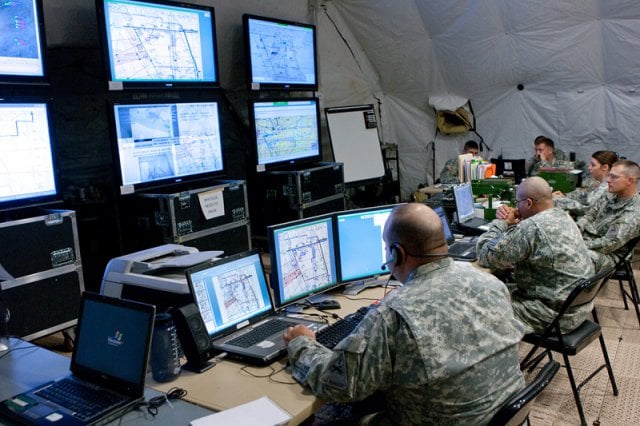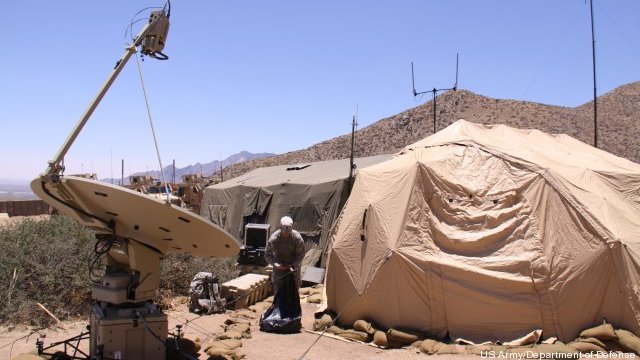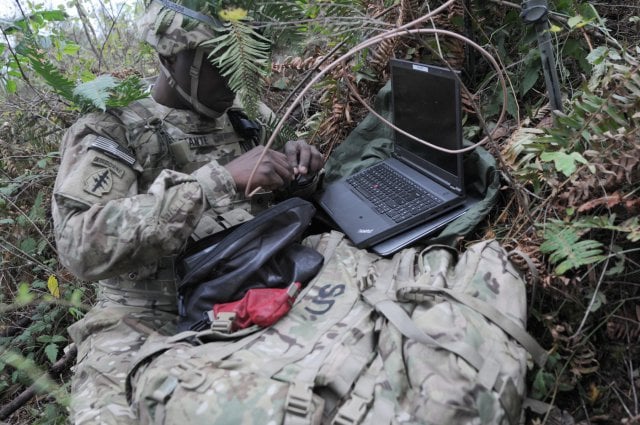Army To Update 400+ Units’ Software In 28 Months
Posted on

Army command post
Hate updating the software on your smart phone? Then have compassion for the Army, which is trying to standardize its computer systems across more than 400 units in the next 28 months. The objective is a “single software baseline,” where every unit has the same set of information technologies. Such standardization should simplify everything from training, maintenance, operations and future upgrades.
The baseline effort is part of a much larger overhaul of the Army’s networks. The ultimate goal is to keep troops communicating and coordinated despite cyber attack, jamming, harsh conditions, and the constant movement of a modern Multi-Domain Battle against advanced adversaries such as Russia. While software is less sexy than, say, tanks that shoot lasers or railguns, it’s critical to modernize the Army’s electronic nervous system. But there are legions of devils in the details, as an Army release yesterday outlines.
One particularly devilish detail not in the official release: the cost. I pressed the Army’s spokesman for Command, Control, & Communications – Tactical (PEO-C3T) about this, and he replied frankly that the service doesn’t have a firm figure yet.
For now, “the fielding effort is being executed out of current mission command funding line,” spokesman Paul Mehney told me, using the Army’s more initiative-friendly term for command and control. “We are in early stages of the effort and still formulating resourcing and execution plans across service components (i.e. regular Army, National Guard, and Reserves). At this time it would be premature to define a cost estimate.”
 The cost will be considerable, because the scope, scale and speed of the effort is staggering. It’s not just software, because some units don’t have adequate hardware to run the latest program updates, so they’ll have to get new computers too. What’s more, 15 years of hasty upgrades to meet the needs of Afghanistan and Iraq have left Army units with a hodgepodge of equipment, so each formation might require a slightly different set of updates to get to the desired standard.
The cost will be considerable, because the scope, scale and speed of the effort is staggering. It’s not just software, because some units don’t have adequate hardware to run the latest program updates, so they’ll have to get new computers too. What’s more, 15 years of hasty upgrades to meet the needs of Afghanistan and Iraq have left Army units with a hodgepodge of equipment, so each formation might require a slightly different set of updates to get to the desired standard.
The Army also wants to do this fast, at least by the standards of the Pentagon. In the normal course of events, the Army would field new mission command equipment for 80 to 100 units in any given year and take five years to update every unit in the force. This standardization push – 400-plus units from battalions on up in 28 months – more than doubles that pace. The goal is to convert “up to 280 units” in the US and Pacific in 2018 alone. (Note the priority on the Pacific). Units in Europe, the Middle East, and the rest of the US will follow in 2019.
Oh, and those are fiscal years, so 2018 begins October 1st, just two months from now. Fielding begins this month, less than three months after the Army’s Pentagon staff (section G-3/5/7) ordered the overhaul in May.
To cope with the pace, the Army’s mission command training team has more than tripled, from 28 people to 94. That’s still not much for a million-man Army, though. So instead of sending out trainers to every unit to teach them about new gear, as it usually does, the training team will have troops come to several centralized locations around the country. Fort Campbell, Kentucky and Fort Hood, Texas, have already been identified as training sites. The service plans to set up centralized training at some National Guard sites as well.

A soldier from the Army’s offensive cyber brigade during an exercise at Fort Lewis, Washington.
If all this succeeds, Army troops will find their networks much easier to manage in the future. Today, for instance, a single brigade command post might have as many as five different types of laptops and four types of server stacks; the goal is to get that down to two types of each. In particular, the logistics software called Global Command and Control System – Army runs on different hardware than the Battle Command Common Services. The standardization plan updates GCCS-A to run on BCCS machines, eliminating “approximately 100 dedicated servers and 1,000 client laptops associated with GCCS-A across the Army,” says a service statement.
Similarly, there are a dozen different versions of Command Post of the Future (CPOF) software used by different units. The single software baseline will reduce that to one standard CPOF, the most updated version.
The standardized single software baseline should be much easier to run. The Army expects to shorten training programs by at least 15 percent — more for units currently stuck with older, harder-to-use systems. (System administrator (SYSADMIN) training shortens by 32 hours and system operation (SYSOP) training by eight). It should also be much easier to keep patched and updated, since the same software upgrades can be pushed out automatically to every unit instead of having to manually tailor what each unit gets. Easier, more regular updates, in turn, should help close vulnerabilities to viruses and other malware, improving cybersecurity.
The current effort is hardly the end, either. In 2019, even as the push for a single software baseline is racing for the finish line, the Army will launch a next-generation Common Operating Environment that will continue to simplify its networks.
Subscribe to our newsletter
Promotions, new products and sales. Directly to your inbox.
